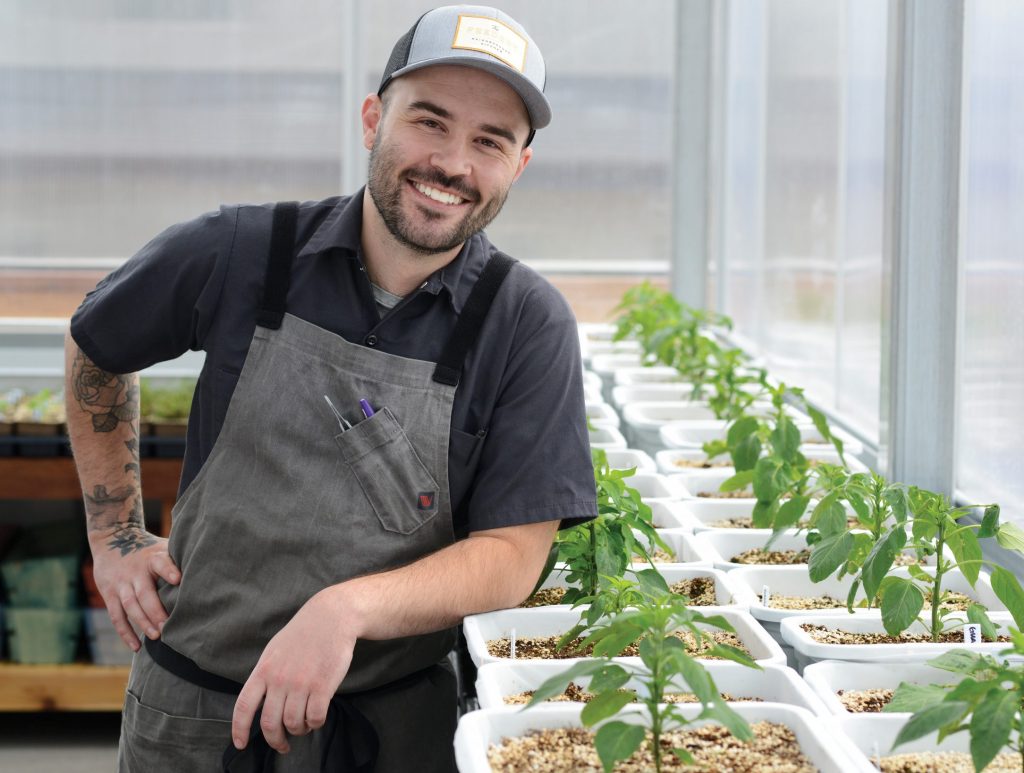
We eyeball the flimsy carrots languishing in the bottom of the produce drawer in the fridge, and we don’t think twice about tossing them in the trash. And the leafy carrot tops? Nothing more than useless trimmings. But for Jeff Schwing, executive chef of seven-month-old The Feedery at Grow and Gather—the restaurant, farm, garden, greenhouse, market and communal gathering place on Old Hampden—his surplus of cosmetically imperfect scraps has more benefits than you can imagine. Schwing is one of several chefs across Colorado who’s trending toward a zero-waste food model. “Founder/owner George Gastis and I want to try to create an ecosystem of sustainability,” he explains. “We’re not trying to reinvent the
wheel—but we are trying to make it better any way we can.”
Schwing is fighting a very, very big problem: food waste. In the United States alone, a staggering 30-50 percent, roughly, of food gets flung into the garbage bin every year. That’s the equivalent of about $160 billion in annual waste and 1,160 pounds of food, on average, that’s trashed each year by a family of four. And then there are the environmental ramifications, including the generation of greenhouse gas emissions caused by the production of uneaten food.
The consequences of food waste, which have only been highlighted after months of unprecedented food shortages and struggles, are widespread and heartbreaking. This is why it’s so vital to take steps to minimize our food
waste and maximize our efforts to eat what we have on hand. “Reducing food waste is about making small, daily decisions,” says Schwing.
And while those decisions may seem “mundane and insignificant, it’s the little things that make the biggest difference,” he adds.
The next time you eye those languishing carrots, think twice about tossing them. Instead, consider these eleven tips from Schwing for reducing food waste and becoming a more responsible, educated and conscious consumer and home cook.
1. EAT THOSE LEFTOVERS! “Eating leftovers—or transforming leftovers into new dishes—is probably the number one way we can reduce food waste at home,” asserts Schwing. Chop up meats and vegetables to use in a crazy-good stir-fry, he suggests.
2. COMPOST WHENEVER YOU CAN. Most municipalities offer a compost collection program, which takes food scraps, yard debris and more that you accumulate at home to a facility to be turned into compost. Do-it-yourself composting takes minimal space, says Schwing: “My dad has been composting for years and turns all his viable waste into fertilizer, which yields amazing results.” The quality of the “waste” that goes into compost makes a huge difference, the chef continues: “Organic food going in will reduce chemical waste in your end product.” A word of advice: If you use a community program, take note of the rules and regulations specifying what can and can’t be composted.
3. REUSE OIL AND FAT as much as possible. Bacon fat, frying oil, coconut oil and many other types of oils can be strained and reused, says Schwing. Hot oils, stored in mason jars and left at room temperature, can add complexity and flavor to dishes. Caution: Don’t reuse oils if they’re dirty, cloudy and don’t smell fresh.
4. PICKLING is a terrific way to maximize aging produce. It’s easy to master, especially with multiple online resources and videos to assist beginners. All that’s really needed to get started, says Schwing, are a few canning jars, any vinegar you fancy and simple aromatics, like black peppercorns, coriander or star anise.
5. FERMENTATION, much like pickling, can extend the life of veggies and several other staples. “At the restaurant, for example, we use expiring heavy cream and buttermilk to make homemade crème fraîche,” says Schwing.

6. WHEN YOU USE A VEGETABLE, use the whole vegetable. Celery leaves and hearts, fennel fronds, carrot tops, beet greens and
lemon rind or zest can be eaten raw and used for garnishes. And most, if not all, vegetable leftovers can be used to make an aromatic, delicious vegetable stock: Just boil onion skins and tops, carrot pieces, celery butts, any stems, green onion roots and garlic ends. Voilà!
7. USING THE WHOLE ANIMAL is also a wonderful way to reduce waste—and it often saves money while providing extra food. “One of the most important lessons any home cook can learn is how to break down and utilize entire cuts of meat,” says Schwing. Bones, for example, can be roasted and thrown into a stockpot with veggie “waste” to add amazing flavor and depth to stocks. “At the restaurant, we use every single part of our amazing chickens. After they’re butchered, we roast the bones, simmer them with veggies overnight, strain the stock and reduce it again to create tasty chicken demi-glace,” he explains. Everyone, says Schwing, should learn how to make stocks and demi-glaces.
8. USE A VACUUM SEALER to preserve food. Yes, there’s an upfront investment, concedes Schwing, “but it pays for itself in no time.” Almost anything—vegetables, meats, soups and stocks—can be vacuum-sealed and frozen.
9. “STALE BREAD IS GOLD,” reveals Schwing. Don’t throw it away. Instead, rehydrate it in cream, egg and sugar for French toast, or dry it completely and give it a light roast with herbs for croutons or breadcrumbs. Another idea? Soak stale bread in milk and add it to meatballs or sausage for moisture and texture.
10. USE SELL-BY DATES and expiration dates as guidelines, not hard-and-fast rules. Use your sense of sight, smell and touch as a gauge. “Never throw something away just because a label tells you to,” advises Schwing.
11. RETHINK YOUR STORAGE, cooking and dining tools. Instead of single-use plastics and paper products, “invest in a good set of oven-safe glassware, multi-size mason jars for storage and cloth kitchen towels and napkins,” says Schwing. Follow the reusable grocery bag trend, and bring your own to-go boxes to restaurants. Recycle those Ziploc bags, which can be washed and reused multiple times.
EAT HERE. LEARN HERE.
The Feedery at Grow and Gather
Old Hampden
Kitchen: 720.535.7217
Market: 720.535.7805


